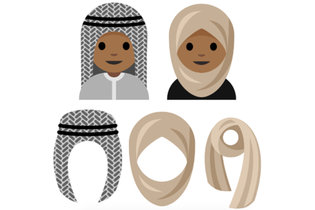The emoji populating virtual reality reflect a increasing range of demographic, fashion, professional and ethnic identities, but one community is missing, and a German teenager is proposing that it be added: emojis for Muslim women and men. From a story in the New York Times:
Ms. [Rayouf] Alhumedhi, who was born in Saudi Arabia and now lives and attends high school in Berlin, began wearing a head scarf at 13. Although she has never been harassed for covering her hair, she has seen people give her some hard stares. All the more reason, she figured, to try to have it included on her keyboard.
“We need to be represented with the amount of diversity, the amount of difference in this world,” she said.
In an online discussion on Reddit on Tuesday, she answered questions about what the hijab meant to her and responded to critics who argued that it represented the oppression of women.
“I would like to be represented and acknowledged,” she wrote. “It might seem baffling, but when I wear the head scarf I actually feel liberated because I’m in control of what I want to cover. The head scarf allows for people to see past a woman’s beauty and see her for her knowledge.”
While Alhumedhi’s experience in Germany has been relatively peaceful, other Muslim immigrants report they have been spat on or insulted.
Alhumedhi first approached Apple and received no response; next she reached out to the Unicode Consortium. Her supporters include a founder of Reddit, and she’ll be in California soon to present her proposal. If accepted, her emoji would go into effect in fall 2017.
This past Tuesday, Alhumedhi initiated a conversation on Reddit about the emoji, though most of the discussion gravitated toward questions and commentary on perceptions of the hijab and the oppression of women. Alhumedhi:
[Alhumedhi]: …a hijab isn’t meant to “protect” women. And not wearing one isn’t assumed to be “tempting” men by default. Those are seriously some very odd assumptions. A hijab (the scarf, along with loose full-body covering) is meant to identify the woman as a chaste Muslim woman and is supposed to give off the signal that this woman isn’t welcoming to any kind of flirting. That is the actual reason it was mandated back in the 7th century. Muslim men are mandated to “lower their gaze” (typical English translation of the Arabic phrase) whether or not a woman is covered properly. No “hiding their sexuality” for women. There isn’t even any implication about anything covered being sexual…
[Q:] But aren’t non-Muslim people able to cover what they want as well? Unless it is for religious purposes, why not wear something else?
I’m not trying to be disrespectful, this is a genuine question. 🙂
[Alhumedhi]: Sure, you can easily wear the headscarf or cover up modestly, without having any religious ties, to achieve the same result. But, keep in mind, while the headscarf plays a role in seeing beyond one’s beauty, it also has religious and traditional meanings behind it. For example, I wear it so my thoughts and ideas are empasized, but I also wear it because many of my friends wear it and we share something in common. I also wear it because inevitably people approach me differently and respect my want for space. To many Muslim women, it also has cultural ties.
A non-Muslim can surely wear it to aim for people looking beyond her appearance, and we would share that aim. However,they would lack cultural and traditional ties.

